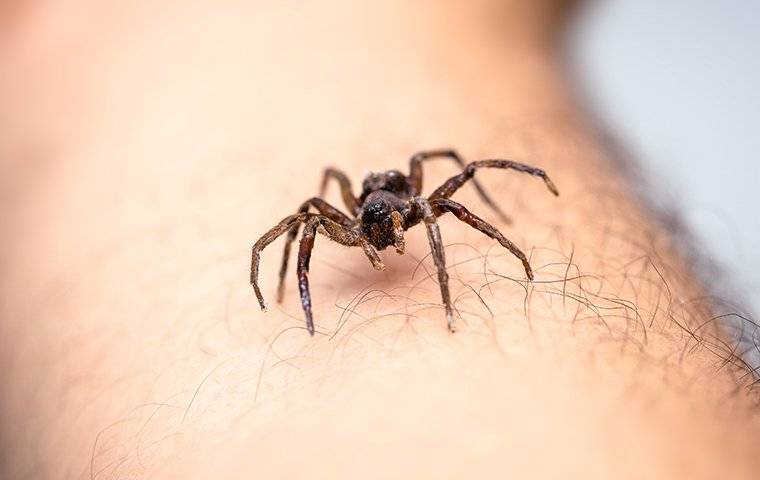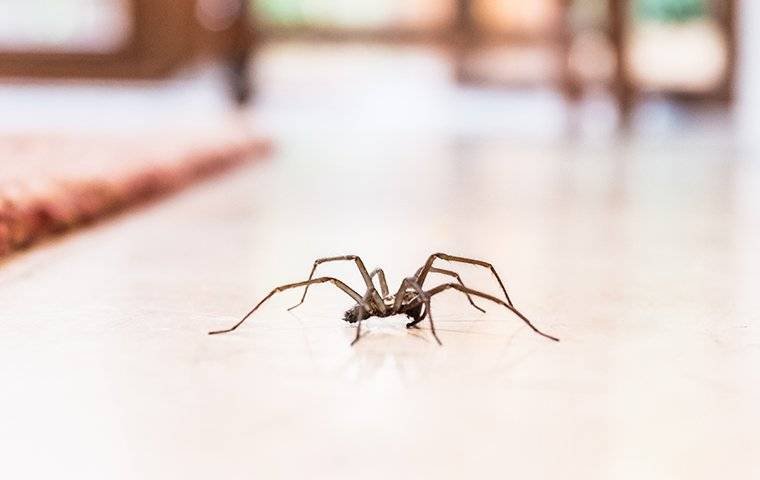It is interesting how most of us are hardwired to recoil from anything with more than four legs. We love our four-legged dogs, cats, horses, and even potbelly pigs, for the most part. Of course, there are four-legged creatures we would rather not have in our houses: squirrels, opossums, and skunks, but we do not have the same visceral reaction to them as we do six and eight-legged creatures.
Insects have six legs and are scary enough — especially the stinging ones, but when you add two legs, the fear factor goes to a new level because people do not want to share their Monmouth County homes with hairy, multi-eyed, creepy spiders!
If you see spiders in your house or keep running into webs when you enter the garage, you need the best pest control in Monmouth County, Alliance Pest Services. Providing top-rated pest removal from local communities using Integrated Pest Management (IPM) strategies since 1983, our highly-trained technicians have the tools and experience to eradicate spooky spiders from your house. We hope you will continue reading to get answers to commonly asked questions.


What Do Spiders In Monmouth County Look Like?
There are roughly 40,000 spider species worldwide, and although many types of spiders in Monmouth County vary in size, color, and habits, they all share common characteristics. A two-segmented body is the first characteristic of all spiders. The first part is called a cephalothorax, which is also called the prosoma.
Spiders are not insects but are in the arachnid class and the subphylum Chelicerata. Animals in the subphylum Chelicerata include crabs, and like crabs, spiders have a hard shell known as a carapace. The carapace is the outer shell that covers the cephalothorax and houses the eyes, mouthparts, and legs.
You can recognize spiders by their multiple eyes. Most spiders have two or more rows of immovable eyes for a total of eight eyes. Some spiders have eyes that are larger than others. For example, many Monmouth County homes have a problem with wolf spiders. Wolf spiders do not create webs but run after and pounce on their prey. Wolf spiders have two large eyes on the front of their head (cephalothorax), and underneath those eyes are four smaller eyes, and on each side of the top of their head, they have another two eyes. These bigger eyes help wolf spiders because most arachnids have poor eyesight, but wolf spiders have excellent vision.
You can identify spiders by their eight legs. Some people think spiders and insects are the same, but insects have three pairs of legs, whereas spiders have four sets of legs. Spiders are in the phylum Arthropoda, which means joint footed in Greek. Hence, spiders have jointed legs, but unlike humans, who have only one joint per leg, spiders have seven joints per leg. Many spiders appear to have hair on their legs, and although this adds to the scary factor, those hair-like structures help spiders sense vibrations, sounds, scents, and air currents. In addition to the hair-like growths, each leg has claws that aid the spider in climbing.
All spiders have mouthparts in the first segment. The mouthparts have hollow fangs (chelicerae), which spiders use to pierce their victims and secret their venom. Hollywood movies and haunted houses love to make spiders the aggressor that hunts humans just like they would a cockroach. But spiders are not aggressive towards humans; they will try to flee from a human and bite only as a last resort if squeezed in clothing or pushed into a corner.
The second part of the spider body is the abdomen, and this area includes the genitals, anus, spiracles, and spinnerets. Of these components, the one that helps identify the creature as a spider is the spinnerets, which they use to produce up to seven different types of silk. We all think of spiders spinning webs, but the reality is that not all spiders use their silk to create webs (i.e., the orb weaver spider), but others use their silk and build parachutes, shelters, and underwater breathing tanks. In summary, all spiders in New Jersey have the following: eight jointed legs, multiple eyes, two body parts, and produce silk.
Is It Dangerous To Have Spiders In My Home?
Spiders in your Monmouth County home are a nuisance, but most are not dangerous. Arachnids are not aggressive and will run from humans but bite if threatened or squeezed. Some, like the yellow sac spider in Monmouth County homes, inflict a painful bite but do not cause symptoms.
Although rare, the Northern black widow is a venomous spider in Monmouth County. Identifiable by their shiny black body stamped with a reddish-orange hourglass on the underside of the abdomen, these spiders create webs near ground level in dark corners in sheds and barns. Increased blood pressure, sweating, and nausea are symptoms of a black widow bite. These signs subside within three hours, and the wounds are not fatal with immediate medical attention. Black widow spiders are prevalent in warmer southern states but rare in our part of the country. The other venomous spider in the United States is the brown recluse spider, but this species is not known to be in this part of the country.
Although most spiders are not dangerous, a high spider population in your Monmouth County house indicates a potential insect problem because spiders eat insects. If you ask, “Why do I have all these spiders in my house” it is because insects are entering your home, and the spiders are following them. Insects in your house can be more problematic than spiders because cockroaches, mosquitoes, and fleas spread diseases, and ants, flies, and moths contaminate food. The spiders in your house may be doing you a favor by catching and eating these insects.
The presence of spiders in your Monmouth County home indicates the need to secure our pest control technicians from Alliance Pest Services to determine the attractants to spiders to your Monmouth County house.
Easy & Effective Spider Prevention Tips
Spiders are a part of the ecosystem, but we do not want spiders crawling over us while we sleep at night, nor do we want to walk into spider webs when we walk down into the basement. These tips will not only keep spiders away but will also deter insects from entering your Monmouth County house:
Remove clutter from the yard: Spiders and insects hide underneath rocks, logs, tree stumps, leaf piles, and firewood stored on the ground. If you use firewood, move the wood at least 20 feet from the house and elevate it to allow for airflow and moisture reduction.
Eliminate standing water from the yard by utilizing proper drainage for ditches and low-lying areas: Remove water-collecting items such as bird baths, child swimming pools, and old tires; this will reduce the mosquito population and deter spiders.
Seal cracks in the foundation, underneath the roofline, and around window and door frames with caulk: Identify cracks in the foundation and roofline by shining a flashlight in those areas at night while someone outside marks the openings.
Repair holes in the screen on the doors, windows, and vents: If you do not have screens, add a 1/4 inch wire mesh on the attic, crawlspace, and chimney openings. The screens will deter rodents and wildlife from entering your house and bringing fleas that attract spiders.
Prune shrubs and trees away from the house: Spiders, insects, rodents, and wildlife can use the branches as highways onto your home’s roof and then access your attic. Overgrown bushes reduce airflow creating moist areas conducive for insects and spiders.
Replace incandescent outdoor lights with a bug or LED lights: Light attracts moths, termites, and others to your porch and deck. Large gatherings of insects then allure spiders; the spiders create webs ensnaring their prey flying around the light. Using a bug light bulb or LED bulb will reduce the insect and spider population around your house.
emove clutter from the garage, basement, and attic: When spiders and insects enter Monmouth County homes, they search for dark nesting locations and old boxes, piles of clothing, and magazines that provide the perfect areas.
Dehumidify the home: Like most insects, spiders need moisture to survive. Damp areas of the house attract cockroaches which attract spiders. When spiders find a location in the home where there is food and water, they will create nests and begin reproducing.
These tips are natural ways to keep spiders away from your Monmouth County house.
The Secret To Total Spider Control In Monmouth County
Spiders in your house are usually the result of a high insect population and require pest control professionals to get rid of spiders. When our technicians inspect your home for spiders, we will determine the attractants, likely entry points, and hot spots. We use Integrated Pest Management solutions to create a strategy to remove the spiders from your Monmouth County home. Our almost forty years of experience and success make Alliance Pest Services your best choice. Call us today and request your free quote.
Latest Blogs
Stay informed about pests and pest related issues in your area!
Dangerous Spiders Of Columbia, MD
If three different spiders are placed in front of you and you are told to pick up the harmless one to win a million dollars, would you feel confident enough to do it?
The Easiest Way To Get Bats Off Your Monmouth County Property
Do you see an increased amount of bats around your home lately? Learn the best way to get bats off of your property.
Are The Fleas In Monmouth County Causing You Headaches?
Prevent and treat fleas with help from Alliance Pest Services in Monmouth County.
Request Your Free Quote
"*" indicates required fields


